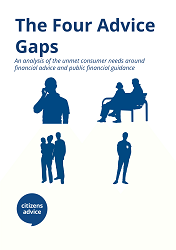The four advice gaps - exploring the different gaps in provision of and access to free and paid money advice
On this page
Successive governments have attempted to improve financial capability, saving rates and attitudes towards retirement planning. Those changes have become increasingly important to families’ financial security as people are given more freedom and choice about how to manage their money.

The last government launched the Money Advice Service (MAS) and introduced tighter regulation of the financial advice sector through the Retail Distribution Review (RDR). These reforms aimed to make free money guidance more accessible and improve the quality and transparency of paid for financial advice.
The impact of those changes is now under review through the Financial Advice Market Review (FAMR) and the Government’s consultation on public financial guidance. There are concerns that the provision of free money advice is not as effective as it could be and that the greater regulation of financial advisers has made it more expensive to access advice. That perceived price increase has led to what the government and others have termed an ‘advice gap’, affecting people who want to pay for money advice but can’t afford to.
Policy Researcher Joe Lane's Blog
The four advice gaps: The missing benefit of money advice

The breadth of the government reviews - looking at both paid for and free advice - as well as our research and experience, suggests a more nuanced reading of the shortcomings of the money advice sector is necessary. There is not a single advice gap, affecting those who want advice but can’t afford it. There are a series of gaps which lead to a range of people missing out on the benefits of money advice and the security that it affords.
Using that broader definition, The four advice gaps 1.01 MB , we have identified four advice gaps:
The affordable advice gap affects consumers who are willing to pay for advice but not at current prices. Our research suggests that up to 5.4 million extra people would consider paying for advice if it cost less.
The free advice gap affects people who want advice but are unable to pay for it. Up to 14.5 million people who think they would benefit from free advice haven’t taken any in the past two years. The free advice gap includes:
The awareness and referral gap affects people who are not aware that advice exists, or where to get that advice. As many as 10 million people who think they would benefit from free advice are not aware of public financial guidance. The awareness and referral gap includes:
The preventative advice gap affects those who would benefit from having money advice as a preventative measure. We found that as many as 23 million people have fallen into a preventative advice gap at least once in their life.